Top Rankings
Falmouth School District ranks among the top 20% of public school district in Massachusetts for:
Category
Attribute
Student Attention
Lowest student:teacher ratio (Top 1%)
For the 2025 school year, there is 1 public middle school serving 459 students in Falmouth School District. This district's average middle testing ranking is 6/10, which is in the top 50% of public middle schools in Massachusetts.
Public Middle School in Falmouth School District have an average math proficiency score of 45% (versus the Massachusetts public middle school average of 38%), and reading proficiency score of 40% (versus the 42% statewide average).
Minority enrollment is 25% of the student body (majority Hispanic), which is less than the Massachusetts public middle school average of 53% (majority Hispanic).
Overview
This School District
This State (MA)
# Schools
7 Schools
526 Schools
# Students
2,892 Students
299,731 Students
# Teachers
286 Teachers
26,316 Teachers
Student : Teacher Ratio
10:1
10:1
District Rank
Falmouth School District, which is ranked within the top 50% of all 393 school districts in Massachusetts (based off of combined math and reading proficiency testing data) for the 2021-2022 school year.
The school district's graduation rate of 88% has decreased from 92% over five school years.
Overall District Rank
#157 out of 397 school districts
(Top 50%)
(Top 50%)
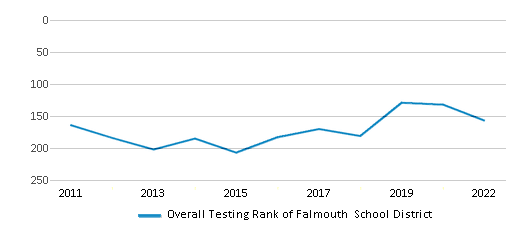
Math Test Scores (% Proficient)
49%
41%
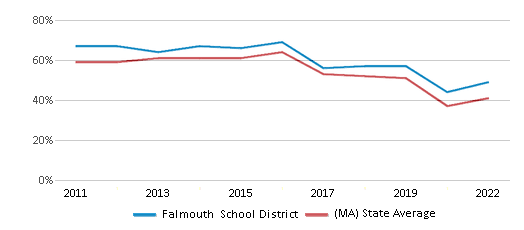
Reading/Language Arts Test Scores (% Proficient)
48%
44%
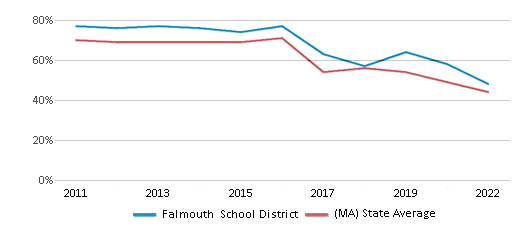
Science Test Scores (% Proficient)
49%
44%
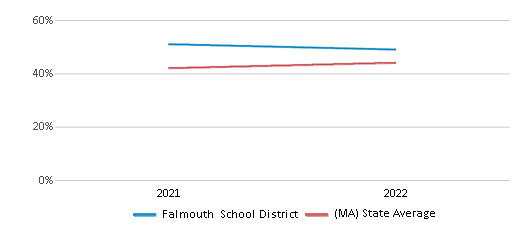
Graduation Rate
88%
90%
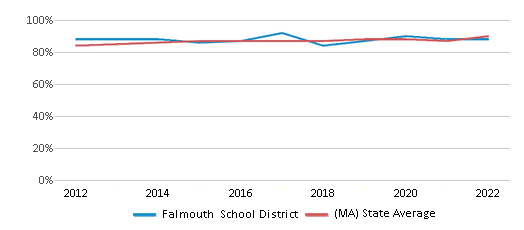
Students by Ethnicity:
Diversity Score
0.43
0.68
# American Indian Students
33 Students
816 Students
% American Indian Students
1%
n/a
# Asian Students
48 Students
21,318 Students
% Asian Students
2%
7%
# Hispanic Students
301 Students
84,297 Students
% Hispanic Students
10%
28%
# Black Students
148 Students
37,053 Students
% Black Students
5%
12%
# White Students
2,153 Students
142,107 Students
% White Students
75%
48%
# Hawaiian Students
n/a
291 Students
% Hawaiian Students
n/a
n/a
# Two or more races Students
201 Students
13,358 Students
% of Two or more races Students
7%
5%
Students by Grade:
# Students in PK Grade:
118
2,713
# Students in K Grade:
202
7,222
# Students in 1st Grade:
211
7,530
# Students in 2nd Grade:
257
7,944
# Students in 3rd Grade:
205
8,002
# Students in 4th Grade:
233
8,676
# Students in 5th Grade:
232
19,802
# Students in 6th Grade:
248
55,437
# Students in 7th Grade:
227
68,011
# Students in 8th Grade:
232
68,221
# Students in 9th Grade:
196
11,995
# Students in 10th Grade:
165
11,729
# Students in 11th Grade:
189
11,460
# Students in 12th Grade:
172
10,610
# Ungraded Students:
5
379
District Revenue and Spending
The revenue/student of $27,396 is higher than the state median of $23,845. The school district revenue/student has stayed relatively flat over four school years.
The school district's spending/student of $28,753 is higher than the state median of $24,602. The school district spending/student has stayed relatively flat over four school years.
Total Revenue
$79 MM
$21,850 MM
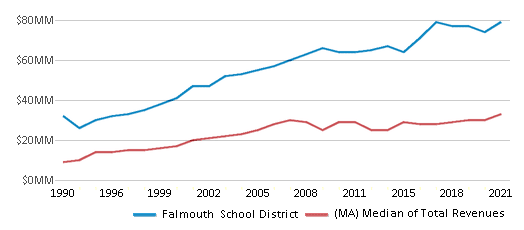
Spending
$83 MM
$22,544 MM
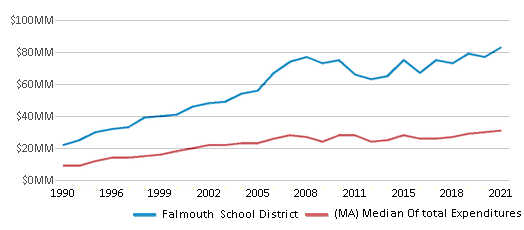
Revenue / Student
$27,396
$23,845
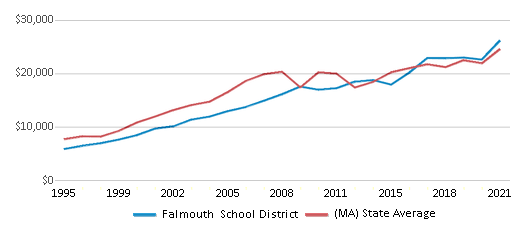
Spending / Student
$28,753
$24,602
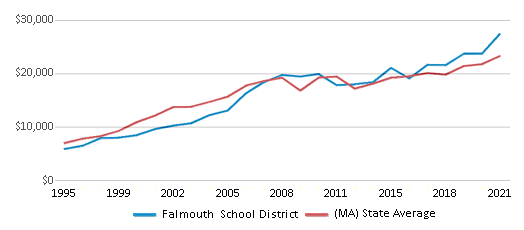
Best Falmouth School District Public Middle Schools (2025)
School
(Math and Reading Proficiency)
(Math and Reading Proficiency)
Location
Grades
Students
Rank: #11.
Lawrence
(Math: 45% | Reading: 40%)
Rank:
Rank:
5/
Bottom 50%10
113 Lakeview Avenue
Falmouth, MA 02540
(508) 548-0606
Falmouth, MA 02540
(508) 548-0606
Grades: 7-8
| 459 students
Recent Articles

Sexual Harassment at Age 6: The Tale of a First Grade Suspension
A six-year old in Aurora, Colorado, was suspended after singing an LMFAO song to a little girl in his class and reportedly “shaking his booty.” We look at the case and the sexual harassment problem in public schools today.

How Scaffolding Could Change the Way Your Child Learns
This article explores the concept of instructional scaffolding, a teaching method that enhances learning by breaking down complex tasks into manageable parts. It highlights how scaffolding supports students in developing critical thinking skills and becoming more independent learners. The article discusses the benefits of scaffolding, including improved engagement and reduced anxiety, and provides strategies for its implementation across various educational levels.

February 05, 2025
Understanding the U.S. Department of Education: Structure, Impact, and EvolutionWe explore how the Department of Education shapes American education, from its cabinet-level leadership to its impact on millions of students, written for general audiences seeking clarity on this vital institution.





